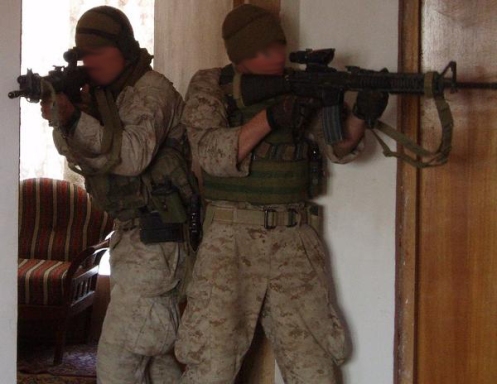Combat Stance
Imagine a boxer’s fighting stance, now add a weapon in his hands. That’s how you should look. Your body is square to the target and your head is not lowered to the sights. In this position, you have maximum mobility coupled with effective engagement on your target.
Consider this picture below. The shooter on the left is nearly perfect while the shooter on the right (me) needs to have the butt higher in the pocket of his shoulder so he doesn’t have to adjust his neck.

Feet
A common thing I see people doing incorrectly is opening up the toes on the stance. That is, when they drop their support leg back to fire, the toes end up pointing out from where the target is. It usually ends up making a right angle, give or take a few degrees. While this ultimately will have little effect on how well you can engage a target, it does have an effect on how you manage recoil and certainly on your mobility.
Having both feet point directly at the target is a fundamental of having your natural point of aim. Having a natural point of aim is very important for follow-on shots as well as a higher percentage of first round hits.
Keep your weight off your heels. That doesn’t mean stand on your toes, but center your weight slightly forward so that at least on your rear foot you can feel most of the weight transferring to the ball of your foot.
The hard and fast: The feet are about as far apart as your shoulders (shoulder-width), your strong side foot (coincides with handedness) is dropped slightly to the rear ( roughly about the toes online with the heel of the opposite foot), toes point at the target.
Legs and Hips
Think of your body system like it’s a tank. The shooting platform is the upper torso, the mobility platform is the lower half of your body. It also could be compared to how the Master Chief 3D model moves in the Halo games. This section is semi-redundant of the feet section.
Naturally, if your strong side foot needs to be slightly to the rear, so must the leg of the foot it’s attached to…if your feet and hips are lined up a certain way, your hips can’t be any other way.
In addition to all the feet pointers, your knees should be slightly bent, and never locked (that’s when you straighten your legs and they’re not supported by muscle, but bone on bone stability. You can feel it when you stand and your knees sort of…lock…into place). This gives a system of flexible support, like shocks in a vehicle. You are able to better stay on target when moving because the impact of movement is absorbed up by your knees. That keeps it from transferring all the way up your body to your sights.
It also helps absorb recoil, giving you faster follow on shots.
Back
The back, or more specifically the spine, is the vital component of the upper torso shooting platform concept. All other parts cannot be perfect if the back isn’t perfect.
Your spine needs to be straight as a rod. Not only is this fundamental to combat shooting, but it prevents injury to the muscles and spinal column. If your spine gets jacked up somehow, the nerves running inside it could jack up literally anything, from losing feeling in your toes, to never walking again, to not being able to have kids.
The potential problem people have with this portion of the technique is that you are supposed to lean slightly forward. This is done more in the hips than in the back. Your upper body weight is shifted slightly forward, toward the target, but your back stays straight. Often, people curl their back and bring their shoulders into it. This does help absorb recoil, but since it’s not a major pivoting joint in the machine, it screws up follow on shots because you no longer have a natural point of aim that your body falls back into.
Shoulders
Theoretically, your shoulders should be square to the target, and aligned with the hips, but that generally only works for range training your combat stance with targets.
Depending on how big you are, and the size of your weapon, you may have to modify your stance. Being a smaller individual, I am still capable of keeping squared shoulders with an M4 and shortened buttstock, but cannot with an M16 and especially not a full stock shotgun. The result is a combat stance that leaves my upper body slightly bladed to the target.
In a gunfight, you need to be maneuvering as well as shooting. With the “body like a tank” combat stance concept in mind, the shoulders may not always be aligned with your hips, but your natural point of aim will be more consistent if they are.
Elbows
Elbows are tucked in tight to the body. This may be difficult for the weaker individuals at first, but if you force yourself to do it, you will develop the muscles. Believe me, I was one of the weaker ones. Keeping your elbows in keeps them from getting shot off and allows for greater control of the rifle and recoil (*ahem* if your airsoft rifle has recoil). You are pulling back and down, instead of just back. In the long run, it actually fatigues you less. It takes more muscle and effort to hold your elbow up all day.
Keeping your elbows in maintains consistency in weight distribution. Knowing how your body moves will enable you to more effectively win the fight if you are more stable individual. Every martial arts style and system of combat has loads of theory on stability, center of gravity, keeping yours, and hampering the opponents. Having your elbows sticking out broadens the center of gravity and it’s more likely to affect your balance and stability if something were to contact your elbow. In essence, you are providing a lever with which something can turn your body.
Ultimately though, it keeps you from looking like a retarded Black Hawk Down Delta impersonator like the guy on RenegadeRecon‘s site…
Head
This will be the trickest, but most vital, muscle memory to reprogram for most people. Your head does not move toward the sights. The weapon must be held so that it lines up with the eye. Examine the picture of me above, a properly positioned buttstock would put the bottom point of it in my shoulder pocket about where the brown strap of the sling is.
The actual axis of recoil is above the shoulder line. This fact alone causes many people to assume a lower shoulder weld and disregard this technique. While the recoil would be harder to manage for someone not properly employing every aspect of this stance, there is some trade-off happening. The line of recoil being above the shoulder causes significantly more muzzle climb than having it transfer directly into your shoulder. However, if you lean into the target, shift your weight to the balls of your feet, stay square to the target, and keep your elbows in and pulling down, you will be able to recover from the recoil just as fast, and still be on target.
Regardless of how tight you keep the rifle in your shoulder pocket, the point of the buttstock hitting that concentrated region will cause quite a bit of pain. The upside is, the old adage “the more you hurt in training, the less you hurt in war” holds true. Eventually, the nerves in that region will deaden and cease to cause pain, and then your technique will be flawless.
Eyes
Keep both eyes open at all times. At the ranges airsoft (and MOUT environments) tend to play out at, you need maximum peripheral vision. When you first start practicing this, and I still need to do this, you may need to slightly squint your support side eye. That will cause your eye in the sights to procure a more dominant place in the way your brain sees the image.
For some individuals, they were taught to be right handed, when really, they are left-eye dominant, as I was. So now I do nearly everything right handed, but the picture my brain sees is more often dictated by my left eye’s focus. To compensate, when I pick up my sights in my eye, I squint my left eye until my right eye clearly sees through the sights, then fully open both.
References:
- Infantry Rifleman Course>Student Handout Booklet (USMC)
- USMC Weapons Drill Guide
- Military Operations on Urbanized Terrain MCWP 3-35.3











